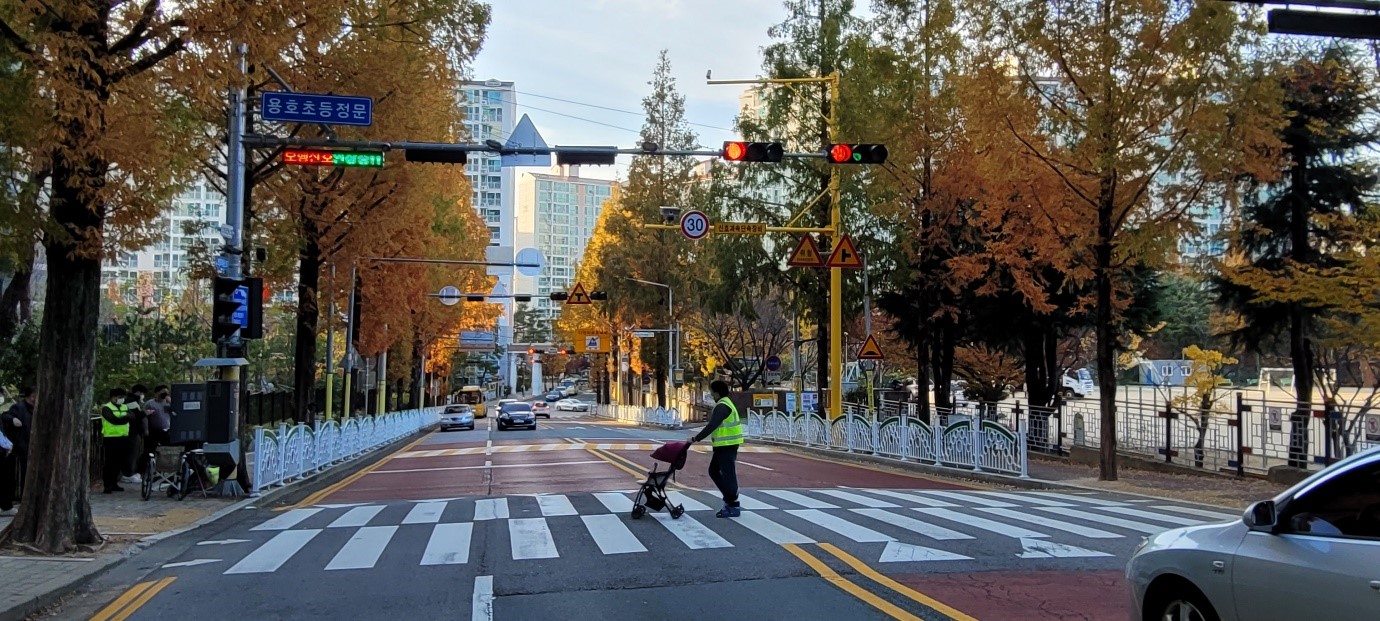※ Introducing Korea’s Best Practice of Local Governments for Older Persons. This is a monthly report that aims to introduce examples of outstanding policies and practices adopted by local and municipal governments in; Korea to help older persons exercise their human rights. These examples are selected with reference to the report ‘Human Rights to be Included in the New UN Convention on the Rights of Older People’, published by the National Human Rights Commission of Korea in 2018. While various attempts have been made by local and municipal governments in Korea to improve the well-being of older persons, they are not very well known outside the country. ASEM Global Ageing Center (AGAC) aims to fill this gap by introducing in depth the best practices local governments have implemented in the interests of older persons.
The second case that AGAC has selected is the ‘Automatic Walking Signal Extension System’, introduced by Changwon-si (‘si’ refers to a district unit with a population size of around 50,000), which itilizes an artificial intelligence (AI) system to automatically extend the walking signal time at a pedestrian crossing.

A System for Protecting Vulnerable Pedestrians Using Artificial Intelligence:
Changwon-si's Automatic Walking Signal Extension System.
Technological advances are progressing at a rapid pace and are increasingly affecting our lives. Artificial intelligence (hereinafter referred to as AI) is one of the major areas of development in science and technology. Although the definition of AI is diverse and cannot be limited to one category, this report defines it as a system that acts like a human being (Turing, 2009). In Korea, AI is commercialized in various fields such as data mining, voice recognition, computers, and robots. The areas to which AI has been applied have been expanded.
In Korea, AI is contributing to improving older persons’ quality of life. AI has already become an important part of the care and medical fields. For instance, care robots can relieve the isolation and loneliness of older persons living alone, and prevent a lonely death. AI is being applied in various ways not only in improving the quality of life of individuals but also in the social and public fields. This report introduces Changwon-si's Automatic Walking Signal Extension System to protect vulnerable pedestrians as a representative example of AI designed to serve the interests of the community.
Changwon-si has been operating the country's first Automatic Walking Signal Extension System since November 2021. It was installed in accordance with National Police Agency standards as a pilot project. This system automatically extends crossing time by 5 to 10 seconds when it recognizes pedestrians who have not managed to cross within the regular signal time. In order to protect vulnerable pedestrians and prevent accidents, the system was installed in the children's protection area in front of Yongho Elementary School in Uichang-gu, Yongho-dong, Changwon-si. Although this system was installed in a children’s protection area, it is also beneficial to the older persons and other vulnerable pedestrians. (Project budget of Automatic Walking Signal Extension System is about 41 million KRW, about twice as much as the installation cost of general traffic lights of 20 million KRW)

According to the Korea Transportation Safety Authority, 57.5 per cent of traffic accident deaths among pedestrians in 2020 were of older persons. The proportion of older persons has increased three years in a row, from 46.6 per cent in 2018 and 57.1 per cent in 2019. In addition, 54.8 per cent of pedestrian accident deaths among older persons occurred while crossing the road. In this context, the Automatic Walking Signal Extension System appears essential for improving the safety of older pedestrians.
Although it has only been in operation for about four months, it is planned to gradually expand the system, along with the Leading Pedestrian Interval technique, if evaluation demonstrates positive effects.
* The Leading Pedestrian Interval system: A Leading Pedestrian Interval (LPI) typically gives pedestrians a 3–7 second head start when entering an intersection with a corresponding green signal in the same direction of travel (National Association of City Transportation Officials, 2022).
Changwon-si's Automatic Walking Signal Extension System is a clear example of how AI can improve the quality of life of older people by assisting vulnerable pedestrians, including older persons. In terms of the human rights of older persons, the use of AI is expanding from micro-care, medical care, and automatic driving to solving the inconveniences of older persons in their daily lives. Older persons are often vulnerable as pedestrians, an inevitable consequence of physical ageing. Recently, local governments in Korea have been making great efforts to help and support the daily lives of older persons. The Automatic Walking Signal Extension System is not only an example of how AI can improve the quality of life of older persons, but is also an example of universal welfare for older persons. The commercialization of AI is likely to be one of the essential factors in improving the daily lives of older persons, and its importance is expected to grow. There are philosophical, moral, and social controversies surrounding the use of AI; however, in this report can show what it can contribute to the human rights and welfare of older people.

Reference
Turing, A. M. (2009). Computing machinery and intelligence. In Epstein & Peters (eds), Parsing the Turing Test (pp. 23-65). Springer, Dordrecht.
National Association of City Transportation Officials. (2015, July 24). Leading Pedestrian Interval. https://nacto.org/publication/urban-street-design-guide/intersection-design-elements/traffic-signals/leading-pedestrian-interval/
Jaesung Lee (being08@asemgac.org)